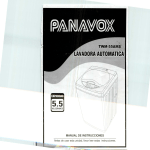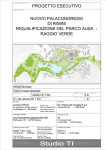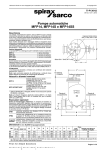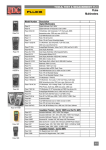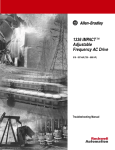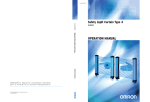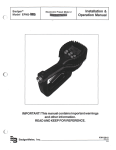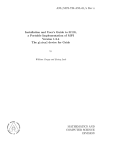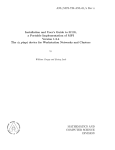Download Assembly Manual Kit Version Cycle 24 Model
Transcript
THIS IS A GENERIC MANUAL TO PROVIDE YOU WITH AN EXAMPLE OF HOW TO ASSEMBLE A CYCLE 24 KIT ANTENNA. ALL SPECIFIC ELEMENT SCHEDULES AND POSITIONS HAVE BEEN REMOVED. MOST NUMBERS HAVE BEEN GIVEN THE DESIGNATION XX. WHEN YOU PURCHASE AN ANTENNA YOU WILL RECEIVE THE COMPLETE MANUAL WITH EXACT DIMENSIONS AND NUMBERS. IN ORDER TO REDUCE YOUR DOWNLOAD TIME, THIS GENERIC MANUAL WAS COMPRESSED. YOU WILL RECEIVE A HIGHER QUALITY MANUAL VIA EMAIL WHEN YOU PURCHASE AN ANTENNA. Assembly Manual Kit Version 90 MPH KIT Cycle 24 Model Cycle 24 Limited Warranty and Liability Cycle 24 (“Manufacturer”) warrants to the original purchaser that this product will be free from defects in material, and workmanship for a period of one (1) year from the date of purchase. The determination of whether any part or parts will be covered under warranty and whether any part or parts will be repaired, replaced or refunded will be solely determined by Cycle 24. Such determination will be made following evaluation of claim of alleged defect and subject to evaluation of possible misuse, abuse, unauthorized modifications, extreme weather conditions or improper installation. This warranty does not cover transportation, installation or any other costs that may be incurred from any defect whether known or unknown. The purchaser, final customer, installer and user of these products individually and collectively acknowledge that these products can cause injury or death and individually and collectively accept full responsibility and liability for any and all personal and property damage (direct, indirect and punitive) caused during installation and subsequent use. Copyright Notice This publication and corresponding antenna design, both electrical and mechanical, is Copyright 2012, by Cycle 24. All rights reserved. . This publication contains proprietary information and no part of this publication may be reproduced, stored in a retrieval system or transmitted in any form or by any means, electronic, mechanical, photocopying, recording or otherwise, without prior permission. Warning Installation of this antenna near power lines is dangerous. Contact with any high voltage power lines could result in electric shock or loss of life. Do not install this antenna where there is any possibility that the antenna or any part of the supporting structure could come in contact with power lines. Also ensure that no persons or pets can come in any contact with the antenna after it is installed. Dangerous voltages can exist on the antenna when it is in operation and no part of the system is insulated to prevent shock. Consult with FCC OET Bulletin 65 to properly evaluate whether the chosen installation site for this antenna will comply with the FCC guidelines for human exposure limits to radio frequency electro-magnetic fields. VDX512 -2- Revision 3-22-2013 Refer to the manufacturer’s user manual for all tools used during the assembly and installation of this antenna. Cycle 24 is not responsible for any injuries incurred during the assembly or installation of this antenna. Contact If you have any question regarding the assembly or operation of this antenna, you may contact Cycle 24: Cycle 24 - Antenna Products Co. PO Box 2233 Harrison, AR 72602-2233 (870) 715-8228 (870) 416-9940 Email addresses: [email protected] [email protected] [email protected] VDX512 -3- Revision 3-22-2013 PARTS LIST Boom Assembly Parts Part # 1 2 3 4 5 6 7 8 9 10 VDX512 Description 2.0” x 5/16” U-Bolt and Saddle Clamps/ Nuts- 2 (Boom to Mast Plate) 1.5” x .058” x 72” (Boom Center) 1.25” x .058” x 72” (Boom Ends) ¼” x 20 x 2” Bolts and lock nuts- 2 (attachment of 1.25” to 1.5” boom pieces) Element to boom plate (2” x 6” x 3/16”) Driven Element V Plate (4” x 11” x 3/16”) Boom to Mast Plate (4” x 6” x 3/16”) 1.5” x 5/16” U-Bolt and Saddle Clamps/ Nuts-2 (two element plates and boom to mast plate) 1.25” x 5/16” U-Bolt and Saddle Clamps/ Nuts- 2 (6 element plates) End caps -4- Material Quantity Galvanized 2 Aluminum Tube Aluminum Tube Stainless Steel 1 2 4 Aluminum Plate 4 Aluminum Plate 1 Aluminum Plate Galvanized 1 6 Galvanized Rubber Revision 3-22-2013 6 2 Element Assembly Parts List – Refer to part numbers by antenna model and part number Part # 1 2 3 4 5 6 7 8 9 10 11 12 13 14 15 16 Description Material .625" x .058” x 72" (All elements) .5” x .058” x 36” (All elements) .375” x .040” x 55.5” (Reflector) .375” x .040” x 53.5” (Driven Element) .375” x .040” x 48.5” (1st Director) .375” x .040” x 44.25”(2nd Director) .375” x .040” x 39.5” (3rd Director) .625” Element Block Set (2 per set) ¼-20 x 2” Button head Allen Screw (all element blocks) ¼-20 Lock Nuts (all element blocks) ¼-20 Flat Washer (all element blocks) #8-32 x 1.0” Pan Head Bolt (included in driven element assembly) #8 Flat washer (included in DE center section assembly) #8-32 Keps Nut - integrated star washer (included in DE center section assembly) Balun (optional) Tie Wraps (attachment of Balun to boom) 5/32” Pop Rivets VDX512 -5- Total Quantity Aluminum tube Aluminum tube Aluminum Tube Aluminum Tube Aluminum Tube Aluminum Tube Aluminum Tube Polyamide Stainless Steel 5 10 2 2 2 2 2 12 24 Stainless Steel Stainless Steel Stainless Steel 24 24 2 Stainless Steel 2 Stainless Steel 4 Aluminum 1 3 50 Revision 3-22-2013 ASSEMBLY HINTS AND TIPS This antenna uses aluminum tubing and stainless steel fasteners. Although stainless steel resists rust and corrosion which makes it ideal for antenna use, it is especially prone to “galling” when being tightened or loosened. When galling occurs a nut can become seized on the bolt requiring the bolt to be cut or drilled to be removed. Galling most often occurs once a nut has been torqued at least once. The proper solution to prevent galling is to coat the thread of the hardware with an “anti-seize” or “anti-galling” compound designed to prevent galling. If you are removing a nut that has been installed, especially if it was exposed to the elements, even if the threads were pre-treated with an anti-seize compound, it can help to apply a penetrating lubricant during removal of stainless steel nuts to prevent galling. If during the removal or tightening of a nut, you feel the torque required to turn the nut increasing rapidly, the best technique is to stop immediately, liberally apply a liquid penetrating lubricant, work the hardware back in the opposite direction to allow the penetrating lubricant to fully soak and lubricate the threads. If you force a stainless steel nut on or off too far once galling begins, the nut will permanently seize. Aluminum tubing sections telescope together in the element and boom assembly. To prevent corrosion between the overlapping joints which increases electrical resistance between sections and can cause the sections to seize together (preventing disassembly), an anti-seize compound should be applied. Two suggested products are “Penatrox A” manufactured by Burndy, or “Noalox Anti-Oxidant Compound” manufactured by Ideal. This will ensure optimal long term electrical and mechanical performance from your Cycle 24 antenna. On all hardware, resist the urge to over-tighten (torque) the hardware. Especially hardware that uses a nylon lock nut - extreme force is not required. Over-torquing will distort mating surfaces and actually reduce the holding capability and/or strength of the hardware. Once hardware begins seat firmly, it only takes a few more turns to properly torque the hardware. Being consistent in applying torque across fasteners is also important. For instance when applying torque to the two bolts that hold a single clamp on the boom or to the mast, uneven torque between the bolts can reduce the holding power of the clamp. When torquing bolts on a clamp, you should alternate between each bolt applying an even amount to turns to each bolt keeping torque on each bolt as close as possible. This keeps the clamp engaging squarely and maximizes clamping force. You can use the exposed threads on bolts the visually gauge if two bolts have about the same amount of torque. VDX512 -6- Revision 3-22-2013 TOOLS REQUIRED This antenna uses all S.A.E standard tool sizes. 11/32” - Nut driver (for 8-32 nuts on driven elements) 7/16" - Nut driver or socket and ratchet (for ¼-20 nylon lock nuts for boom bolts and mounting blocks) 1/2" - Socket and ratchet (preferred), or combination wrench, or adjustable wrench (for element and boom to mast saddle clamps) 5/32” – Allen Wrench (for ¼” Allen head bolts) 5/32” Drill Bit and Drill Pop Rivet Gun Tape Measure Level Permanent Marker VDX512 -7- Revision 3-22-2013 BOOM ASSEMBLY TOOLS USED: 5/32” Allen Wrench, 7/16” SOCKET, Tape Measure The boom consists of three aluminum pieces of tubing with a six foot length of 1.50 inch outer diameter in the center (with reducers pre-installed inside the ends), and two end pieces that are 1.25 inch outer diameter. Boom pieces are cut, and holes for the ¼-20 x 2” bolts are drilled at the factory. Identify the 1.5” and 1.25” pieces of aluminum tubing using the tape measure. These will be the three largest pieces of tubing that you receive. Center section - 1.5” X 72” End sections (2) - 1.25” X 72”* Secure each end with two ¼-20 x 2.00 inch socket, button head screws and ¼-20 nylon lock nuts. There are two bolts per boom joint. Attach the two rubber end caps on the end of the boom. *Overall length of the 1.25” tubing is 72” while the exposed length is 68.5” per piece. BA1: BUTTON HEAD BOLT AND LOCK NUT Boom Assembly and Element Block Assembly VDX512 -8- Revision 3-22-2013 ELEMENT SORTING TOOLS USED: Tape Measure Use a tape measure to determine the outside diameter and the length of each piece of tubing. Sort the tubing into three piles – .625” (5/8”), .5” (1/2”), and .375” (3/8”). If you feel comfortable, you can also identify the different pieces of tubing visually based on its outside diameter and overall length. Your three piles should have the following pieces: O.D. TOTAL LENGTH QUANTITY USE 5 10 2 2 2 2 2 2 All Element Center Pieces All Elements Reflector Driven Elements 1st Director 2nd Director 3rd Director DE .625” .5” .375” .375” .375” .375” .375” .375” ES 1- Inventory of Element Tubing – 90 mph version After you have your aluminum sorted into three piles, you are ready to assemble the pieces together to make your elements. The pieces in the table ES1 above that are in bold are the center sections for their respective bands. These pieces will not telescope into any larger tubing because they are the largest pieces per band and are the center pieces. POP RIVETING TOOLS USED- POP RIVET GUN, DRILL, 5/32” DRILL BIT, SAFETY GOGGLES. CAUTION: Follow all safety instructions when using pop rivet tools and other potentially dangerous tools. Cycle 24 is not responsible for any injuries related to assembly of this antenna. This section is meant as a precussor to the next section titled “Assembling the Elements”. Use the information that you learn from this section while following the directions in the “Assembling Elements” section. If you have experience using pop rivets, then skip this section and go to the Assembling Elements section. If you do not have experience, then we suggest that you go to Youtube and do a search for pop rivet or how to pop rivet. There will be several simple examples of how to use a pop rivet gun. Below are step by step instructions as well: VDX512 -9- Revision 3-22-2013 1. Using a hand drill or press, drill a 5/32 inch hole through one side of your tubing junction. Do not drill through both sides of tubing. 2. Insert pop rivet into hole. 3. Squeeze rivet gun until you hear a POP. Watch your mark to make sure it does not move while you are drilling your hole. It is usually best to drill with one hand and hold the smaller diameter tubing with the other hand. ASSEMBLING THE ELEMENTS TOOLS USED- MARKER, TAPE MEASURE, DRILL, 5/32” BIT, POP RIVET GUN The following is our recommended procedure for marking, drilling, and assembling elements. 1. Mark all .625” tubing in the center of the tubing at xx inches. This mark will be used later when centering the element onto the element plate. 2. Mark all .5 inch tubing with a permanent marker at xx inches. 3. Slide one .5 inch tube into one side of .625 inch tube with xx inches exposed. Drill and secure with pop rivets. 4. Continue this process until you have 5 elements (driven element and reflector) that have a total of 72 inches of .625 inch tubing in the center with xx inches of .5 inch tubing on either end of your .625 inch tubing. The total length of each of your 5 pieces of tubing is xx”. 5. Next mark all .375 inch tubing pieces xx from one end. 6. Find the two xx pieces of .375” material and insert one into one end of the .5” inch piece. Drill and secure. Repeat this step for the other end of the .5” piece. You should now have an element that is a total length of xx”. Mark this piece with an R in the center of the element to designate it as the Reflector. 7. Continue step 5 for the remaining elements. When completed, the elements will be completely assembled. TAKE YOUR TIME AND MEASURE AS YOU ARE ASSEMBLING THE ELEMENTS TO CONFIRM THAT THE OVERALL LENGTHS ARE CORRECT. The diagram on the next page provides the EXPOSED and OVERALL lengths along with a visual depiction of each elements taper schedule. VDX512 - 10 - Revision 3-22-2013 Note about the picture below. You might be thinking why does it only show XX inches of .625 inch tubing for the center section when I have XX inches of .625 inch material. This is because there is XX inches of .625 inch on each side of the element for a total of XX inches. VDX512 - 11 - Revision 3-22-2013 ELEMENT PLATE MOUNTING TOOLS USED- TAPE MEASURE, LEVEL, ½” SOCKET. The table below shows the position of each element in inches - measured from center to center of each element with the reflector at Position 0. Measure the total length of the boom to see that you have 17’ 4”. Element Reflector Driven Element 1st Director Boom to Mast Plate 2nd Director 3rd Director Position in Inches XX XX XX XX XX XX Position on Boom 1.25” Tubing 1.25” Tubing 1.5” Tubing 1.5” Tubing 1.25” Tubing 1.25” Tubing EPM1: Element Boom Positions EPM 4: Boom to Element Plate EPM 2: Boom to Mast Plate EPM 3: U-bolt Saddle Clamps 1. Mount the boom on a temporary mast or on saw horses so it is elevated off the ground. 2. Sort out all the 1.25 inch U-bolt saddle clamps and all of the 1.5 inch U-bolt saddle clamps. The 1.25” clamp and saddle is the smallest you will receive. The 1.5 inch clamp is the middle sized clamp you will receive. 3. Identify the boom to mast plate (EPM2) and install using 2 1.5 inch U-bolt saddle clamps (EPM3) with the center of the plate at 81 inches. 4. Install the boom to mast plate at approximately 81 inches. As you install the element plates in step 4 and 5, ensure that all of the element plates are perpendicular to the boom to mast plate. 5. Refer to table EPM1 for exact positioning of the element plates. Loosely install all the saddle clamps on the 4 element plates (EPM4) that will be mounted on the VDX512 - 12 - Revision 3-22-2013 1.25 inch boom end pieces. Continue this step for the plate that is mounted onto the 1.5” tubing. 6. Position the reflector element plate with the saddle of the clamp nearest the end of the boom against the end of the black end cap. Use a level and tighten the saddle clamps evenly, so they are tight, using a 3/8 drive ratchet and ½ inch socket (EPM5). Mark this plate as R, designating it as the reflector. 7. Use a tape measure hooked onto the back end of the reflector plate (EPM6) and position the next plate so the measurement to the back end of that plate is 41” for the driven element. Tighten that plate using a level so it will be in line with the first one. Mark as DE designating it as the driven element. 8. Do the same thing for all the plates you have installed using the measurements listed above and marking each plate for its corresponding element. EPM 6: Tape measure attached to the rear of the reflector element plate. EPM 5: Level used on each element plate. EPM 7: Measuring element plate positions on the boom. VDX512 - 13 - Revision 3-22-2013 ELEMENT POSITIONS ELEMENT POSITIONS VDX512 - 14 - Revision 3-22-2013 PLATE AND ELEMENT ATTACHMENT TOOLS NEEDED- TAPE MEASURE, 5/32” ALLEN WRENCH, 7/16” SOCKET, ANTISEIZE LUBRICANT FOR STAINLESS STEEL NUTS AND BOLTS. **Please note, while pictures PEA1 and PEA2 show the element plate to not be mounted on the boom, at this point you should have all of the element plates securely attached to the boom. These pictures are shown to illustrate the attachment of the mounting blocks. 1. Place two halves of the XX inch mounting blocks onto the reflector plate and then place the entire reflector element onto the two clamp halves (PEA 1). PEA 1- Clamp halves with full element PEA 2- Full clamp attached to element 2. Place your mark on the center of the element plate (PEA4). 3. Next place the top two clamp halves onto the element and use the ¼ x 20 x 2” socket head bolts and washers to secure the clamps together (PEA 2 & PEA 3). Apply anti galling lubricant before attaching the nut to the bolt. PEA 3- 2” socket head bolts with flat washers. VDX512 4. Repeat for all elements. - 15 - Revision 3-22-2013 PEA 4: Example element plate with attached mounting blocks. Element center is marked and positioned on the middle of the plate PEA 5: Driven element attached to the element plate. BALUN ATTACHMENT Install the optional balun or your own balun to the #8 bolts on the center of the driven element. Position the balun leads between the bottom keps nut and the flat washer. Secure the balun to the boom with the provided tie wraps. VDX512 - 16 - Revision 3-22-2013 ANTENNA FINAL CHECK AND TEST – PRIOR TO INSTALLATION Dimensions: Refer to figure EPM1 on page 12 and, if there is any question, check the end dimensions of the elements to ensure they are correct. It is highly unlikely a mistake could be made except for the installation of the 3/8” tips sections of the elements. Hardware Installation: Verify that all the hardware has been tightened and there are no loose fasteners. SWR Test You may connect an analyzer with the antenna only a few feet off the ground to make sure you do not have a short or extremely high SWR. The antenna will not have the specified SWR curves unless it is installed at a height of at least 20 feet. With the antenna at least 6 feet from the ground, you will start to see the SWR “dip” below 2:1 somewhere in or near the specified frequency range. As long as you start to see a dip somewhere around (above or below) the frequency range, you may proceed with installation. Installation The antenna should be installed by a professional in a safe manner on a support structure that is rated to handle the weight and wind load of this antenna, in all expected weather conditions. The boom to mast plate is supplied with saddle clamps to mount to a 1.5” or 2.0” outer diameter mast (user supplied). The antenna is designed to be fed with 50 Ohm coaxial cable such as RG-8 or RG213. Pretest the entire run of coax cable with a 50 Ohm “dummy load” to ensure there are no problems with either the coax or the coax connectors. Most SWR issues are due to coax or connector issues and not related to the antenna itself. Even if the coax was previously being used for another antenna, repositioning of the cable can cause new connector issues to occur. You should also test the cable at the full power you intend to run, if possible. Surrounding metallic objects (other antennas, guy wires, etc.) can affect the performance of the antenna. If the antenna is not interacting with anything, you can expect the specified SWR curve, gain and front to rear performance. VDX512 - 17 - Revision 3-22-2013

















